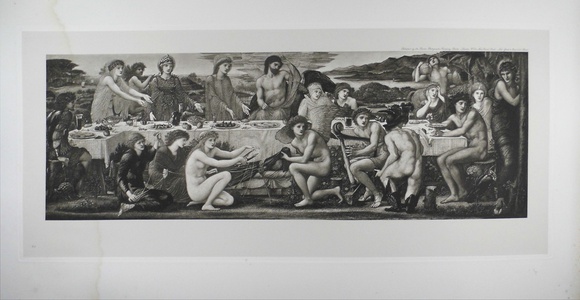| Method | Photogravure |
| Artist | after Sir Edward Coley Burne-Jones |
| Published | Published by the Berlin Photographic Company Berlin. _ London W.133 New Bond Street. _ New York 14 East 23rd Street. [c.1900] |
| Dimensions | Image 172 x 517 mm, Plate 244 x 574 mm, Sheet 507 x 667 mm |
| Notes |
Printed on India laid paper. Plate 61, taken from Burne-Jones' 1872-81 oil painting of the same title, from 'The Work of Edward Burne-Jones, Ninety-One Photogravures Directly Reproduced from the Original Paintings'. Only two-hundred copies of the 'The Work of Edward Burne-Jones...' were produced, each of which was signed by Philip Burne-Jones, the eldest son of Edward. As is typical of many of Burne-Jones' works, 'The Feast of Peleus' finds its subject in antiquity, portraying the wedding feast of Thetis and Peleus, the King of Thessaly. An array of gods and goddesses are presented at the feast. Positioned at the left end of the table are Mars and Vulcan, and at the right, Bacchus, Prosperine, and Ceres. Apollo, playing his harp, sits in front of the table, whilst beside him, Love prepares the marriage couch. Also depicted before the table are the three Fates spinning the web of mortal destiny. Entering at the far right of the composition is the uninvited Discordia presented with bat wings, and hair entwined with snakes. Bringing with her the Apple of Discord to the feast as a prize of beauty, Discordia intentionally fuelled a dispute between Venus, Minerva, and Juno, which acted as a catalyst to the Trojan War. Kneeling in front of the table is Mercury, presenting the apple to the gods, whilst also holding a scroll inscribed with 'Detur Pulcherrimae' ('For the Fairest'). Venus, Minerva, and Juno are depicted standing to the left, each of whom extend their arms expectantly. Jupiter, who refuses to judge which goddess is the fairest, and passes on the task to Paris, a Trojan mortal, is positioned to the right of the three goddesses. Burne-Jones references antiquity not simply through his choice of subject, but also with the compositional structure of the image, that of which resembles a classical frieze. The painting from which this photogravure was taken is now in the collection of Birmingham Museums and Art Gallery. Burne-Jones produced four versions of the same subject, another of which was featured on the 'Troy Triptych', also in Birmingham's Collection. Another larger, unfinished version, is now in the collection of the Victoria and Albert Museum. Sir Edward Coley Burne-Jones, 1st Bt (1833-1898) was a painter and designer closely associated with the later phase of the Pre-Raphaelite movement. Burne-Jones met William Morris as an undergraduate of Exeter College, Oxford, whilst studying for a degree in theology. The pair went on to work very closely together on numerous decorative arts projects including stained glass windows, tapestries, and illustrations. Originally intending to become a church minister, Burne-Jones never finished his degree, choosing instead to pursue an artistic career under the influence of Dante Gabriel Rossetti. Rossetti heavily inspired his early work, but by the 1860's his idiosyncratic style was beginning to develop. His mature work, however different in total effect, is rich in conscious echoes of Botticelli, Mantegna and other Italian masters of the Quattrocento. Thusly, Burne Jones' later paintings of classical and medieval subjects are some of the most iconic of the Pre-Raphaelite movement. He was at the height of his popularity during the 1880's, though his reputation began to decline with the onset of the Impressionists. He was created a baronet in 1894, when he formally hyphenated his name. The Berlin Photographic Company, (1880 - 1920; fl) or the Berlin Photographische Gesellschaft, was a German print publishers who specialised in photogravures after Old Masters and contemporary painters. High quality photographs were taken of the original works. The negatives were then exposed onto a gelatin covered copper plate, etched with acid, and printed in a similar fashion to an engraving. The main series of the Berlin Photographic Company's publications is kept together at Blythe House, West Kensington. Condition: Foxing and discolouration to margins, water stain to left edge of sheet, affecting image. |
| Framing | unmounted |
| Price | £450.00 |
| Stock ID | 41583 |

